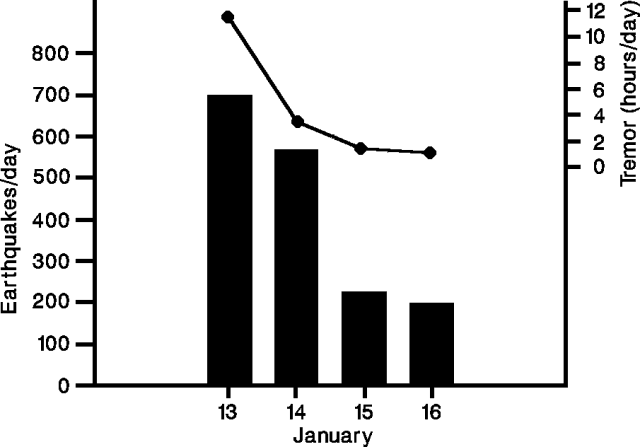Report on Llaima (Chile) — February 1992
Bulletin of the Global Volcanism Network, vol. 17, no. 2 (February 1992)
Managing Editor: Lindsay McClelland.
Llaima (Chile) Microearthquakes and tremor
Please cite this report as:
Global Volcanism Program, 1992. Report on Llaima (Chile) (McClelland, L., ed.). Bulletin of the Global Volcanism Network, 17:2. Smithsonian Institution. https://doi.org/10.5479/si.GVP.BGVN199202-357110
Llaima
Chile
38.692°S, 71.729°W; summit elev. 3125 m
All times are local (unless otherwise noted)
Seismicity was recorded during fieldwork on 13-16 January, using a MEQ-800 portable seismograph, at 1,600 m elev. . . . During the observations, the daily number of microearthquakes decreased from 700 on 13 January, and averaged 418 (figure 2). Tremor frequency oscillated between 1 and 1.6 Hz, with a maximum episode-duration of 70 seconds and a maximum daily total of 11.5 hours (13 January). Seismicity was record<->ed at the same site on 25-30 January 1991, when 650 microearthquakes were recorded, with a daily average of 120 events and a maximum of 140 events (27 January). Tremor frequency oscillated between 1 and 1.8 Hz, with a maximum duration of 55 seconds.
 |
Figure 2. Daily hours of tremor (top) and number of earthquakes (bottom) at Llaima, 13-16 January 1992. Courtesy of Gustavo Fuentealba. |
Geological Summary. Llaima, one of Chile's largest and most active volcanoes, contains two main historically active craters, one at the summit and the other, Pichillaima, to the SE. The massive, dominantly basaltic-to-andesitic, stratovolcano has a volume of 400 km3. A Holocene edifice built primarily of accumulated lava flows was constructed over an 8-km-wide caldera that formed about 13,200 years ago, following the eruption of the 24 km3 Curacautín Ignimbrite. More than 40 scoria cones dot the volcano's flanks. Following the end of an explosive stage about 7200 years ago, construction of the present edifice began, characterized by Strombolian, Hawaiian, and infrequent subplinian eruptions. Frequent moderate explosive eruptions with occasional lava flows have been recorded since the 17th century.
Information Contacts: G. Fuentealba and M. Murillo, Univ de La Frontera; J. Cayupi and M. Petit-Breuilh, Fundación Andes, Temuco.

